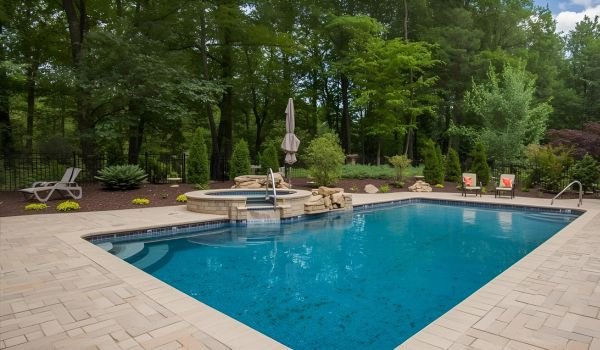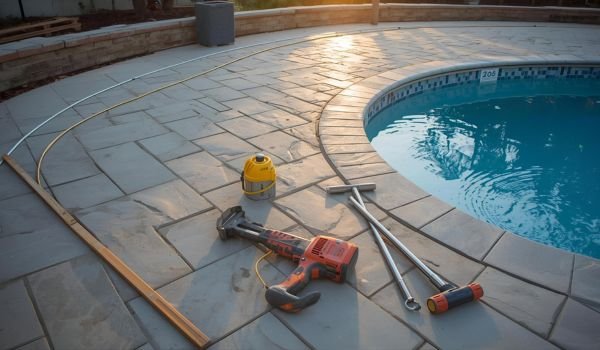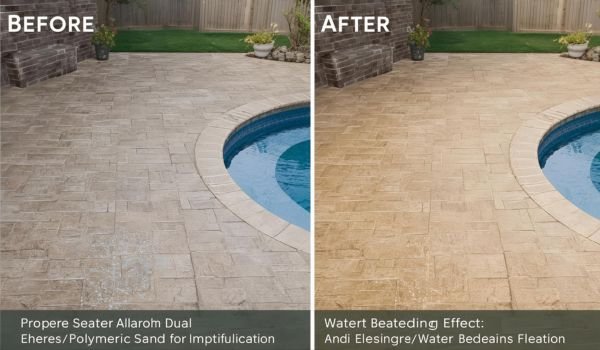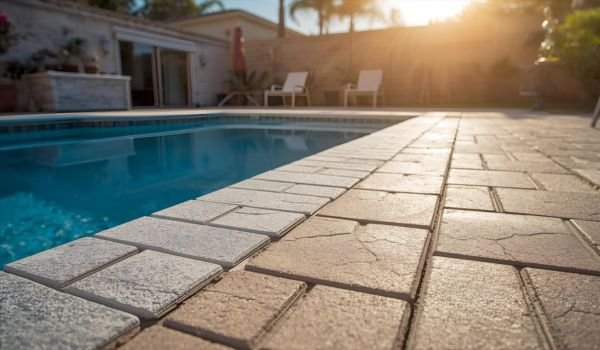Upgrading your pool deck is one of the most impactful changes you can make to your backyard. It enhances the aesthetic appeal and adds functionality to your outdoor space. Pool deck pavers over concrete offer the perfect solution for transforming a tired pool area into a stunning and durable environment. Whether you’re looking to refresh an existing concrete deck or replace it entirely, installing pavers offers many benefits that go beyond just appearance. In this article, we’ll explore why pool deck pavers are so popular, the different types available, the installation process, and how to maintain your new deck for years of enjoyment.
What Are Pool Deck Pavers and Why Are They Popular?

Pool deck pavers are individual paving stones designed to cover the surface surrounding your pool. Unlike traditional concrete, which is poured in one continuous slab, pavers are interlocking stones that can be laid over existing concrete. This type of installation is gaining popularity due to several key advantages.
- Durability: Pavers are much more flexible than concrete, meaning they are less likely to crack under pressure. Their design allows for slight movement, which prevents the surface from cracking over time.
- Improved Safety: Wet surfaces around the pool can become slippery. Many pavers are designed with textured surfaces that provide excellent traction, even when wet.
- Aesthetic Appeal: Pavers come in various materials, shapes, and colors, allowing homeowners to customize their pool deck to complement their backyard’s overall design.
The Benefits of Installing Pavers Over Concrete

Choosing pool deck pavers over resurfacing or replacing concrete has several advantages, making it a smart long-term investment.
- Better Drainage: Unlike concrete, which can trap water on its surface, pavers allow water to flow between the gaps, helping with proper drainage and preventing pooling.
- Easy Maintenance and Repairs: If one paver gets damaged, it can easily be replaced without disturbing the surrounding stones. This is far less expensive and time-consuming than repairing a cracked concrete deck.
- Increased Property Value: Installing pool deck pavers can improve the overall appearance of your backyard, making it more attractive to potential buyers if you decide to sell your home.
Choosing the Right Pavers for Your Pool Deck
Selecting the right type of pavers is essential to ensure both aesthetic appeal and durability around your pool.
Types of Pool Deck Pavers:

- Concrete Pavers: Affordable and available in a variety of shapes, sizes, and colors. These are highly customizable and easy to install.
- Natural Stone: Pavers made from materials like travertine, limestone, or flagstone provide a more luxurious feel. These materials are naturally heat-resistant, making them an excellent choice for hot climates.
- Porcelain Pavers: These sleek, modern pavers are resistant to stains and offer a polished look. They are perfect for those seeking a more contemporary design.
- Non-Slip Features: Wet areas around the pool can become slippery, so it’s crucial to choose pavers that provide good traction. Textured or tumbled stone pavers are ideal for preventing slips and falls, which is especially important for the safety of children and elderly guests.
- Material Considerations: The material you choose should align with your climate and the amount of traffic the area will receive. For example, if your pool is exposed to intense sunlight, travertine is a good option as it stays cool to the touch even on hot days.
Preparing Your Concrete Pool Deck for Paver Installation

Before laying pavers over concrete, preparation is crucial to ensure the installation is smooth and the deck remains stable for years. The preparation steps are fairly straightforward.
- Cleaning the Concrete Surface: Thoroughly clean the concrete to remove dirt, grime, and algae. A pressure washer is an effective tool for cleaning the surface.
- Inspecting the Concrete Condition: Check for cracks or uneven spots. If the concrete is damaged, it should be repaired to create a stable foundation for the pavers.
- Ensuring Proper Drainage: It’s essential that your existing concrete is sloped slightly to allow water to drain away from the pool area. Installing a sand layer between the concrete and pavers can help with drainage by allowing water to flow freely through the gaps.
The Installation Process
To begin installing the pavers, start by laying a foundation of sand or gravel over the concrete surface. This creates a cushioned base that helps keep the pavers in place. Next, position the pavers, starting from one corner and leaving small gaps between them for joint sand. If necessary, use a saw to cut the pavers to fit around edges or obstacles.
Once the pavers are laid out, use a rubber mallet to gently tap each one into place, ensuring they are level and firmly seated. After all the pavers are in position, sweep sand into the gaps to secure them, and consider applying a sealer to protect the pavers from stains and wear, helping them stay in top condition for years to come.
Sealing and Maintaining Pool Deck Pavers

Once your pool deck pavers are installed, it’s essential to maintain them to ensure they stay in excellent condition. Start by sealing the pavers to protect them from stains, moisture, and fading. Choose a high-quality sealer specifically designed for pool decks to keep the pavers looking fresh and vibrant. Regularly sweep the deck to remove debris and prevent dirt buildup, which can cause discoloration over time.
For tougher stains, use a mild detergent or a pressure washer to clean the surface effectively. Additionally, make routine inspections to check for any shifting pavers or damage. If you notice any loose or cracked pavers, replace them immediately to maintain the deck’s integrity and ensure the area remains safe and visually appealing.
Safety and Comfort Considerations
The pool deck should be a safe and comfortable space for all family members and guests. Pavers offer several features that contribute to both safety and comfort:
- Slip Resistance: The textured surface of pavers enhances traction, reducing the risk of slips around the pool.
- Cooler Surface: Pavers like travertine and stone stay cooler underfoot, providing a more comfortable walking surface, even on hot days.
- Flexibility: Since pavers are not a solid slab, they can adjust slightly to ground shifts, which reduces the risk of cracking or shifting that can occur with concrete.
Long-Term Benefits of Pool Deck Pavers Over Concrete

Choosing pool deck pavers over concrete brings long-term benefits. They offer durability, easy repair options, and enhanced aesthetics. Here’s why pavers are a great investment:
- Durability and Longevity: Pavers are designed to last for decades, providing a long-lasting solution to your pool deck needs.
- Low Maintenance: Compared to concrete, which may require costly repairs or resurfacing, pavers are low maintenance and easy to replace if needed.
- Increased Property Value: A well-designed pool area with pavers can increase the value of your home, making it more attractive to potential buyers.
Creative Ideas for Pool Deck Design with Pavers
Pavers allow for creativity in design, enabling you to personalize your poolside area.
- Incorporating Patterns and Borders: Try using different paver shapes and colors to create patterns like herringbone or circular designs. Borders can also add a decorative touch to define the edges of the pool deck.
- Mixing Materials: You can mix paver materials, such as concrete and natural stone, to create contrast and visual interest around your pool.
- Enhancing the Landscape: Add landscaping features such as plants, water features, or decorative lighting to complement your new pool deck.
Conclusion
The cost of installing pool deck pavers over concrete will vary depending on the materials you choose, the size of your pool area, and whether you’re doing it yourself or hiring a professional. While the initial investment may be higher than resurfacing concrete, the long-term benefits of durability, ease of maintenance, and aesthetic appeal make pavers a wise choice.
In conclusion, pool deck pavers over concrete are a fantastic option for anyone looking to enhance their pool area. With a wide range of materials, colors, and designs, you can create a beautiful, functional, and safe pool deck that will last for years. Whether you’re upgrading an old concrete deck or starting from scratch, pavers offer an effective and stylish solution to transform your outdoor space.
